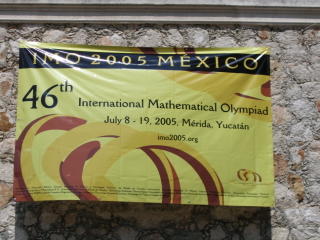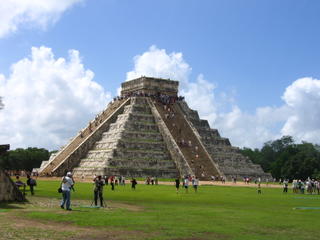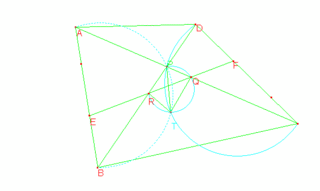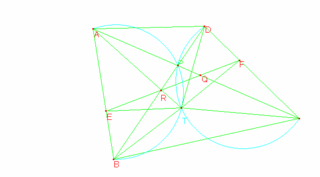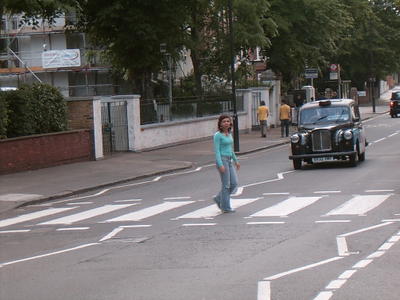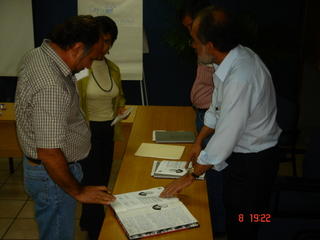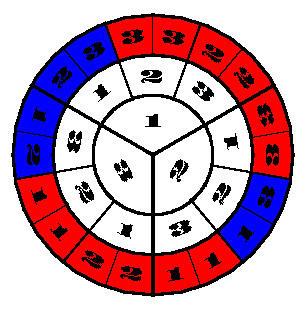National Contest Problem 2 (Monterrey 1997)
There are times when creativity is not enough (what is creativity? ), at least not creativity, in a populist version of the term, calling for the neglect of any theory for the sake of a sort of mystic illumination in the performance of intellectual tasks. I will argue for the proposition that expert knowledge cognizable maximizes efficiency in problem-solving tasks (or at least never is over) on the pretext of the next issue of the national competitive Mexican Mathematics Olympiad. Statement
In a triangle ABC, P and P 'are two points on the side BC, CA Q & A on AB, so that AR / RB = BP / PC = CQ / QA = CP' / P'B. Let G be the centroid of the triangle ABC and K the intersection of AP 'with RQ. Show that P, G and K are collinear. Background Information
(a solution)
In the national contest of WMO (Mexican Mathematics Olympiad) in 1997 for the first time I knew that there was a theorem of Euclidean Geometry called Menelaus Theorem. As is known, the geometry in the school yard occupies a very marginal with a very marked bias in favor of algebra and analytical methods. And this seems to be the case throughout the world for some time now (perhaps since the advent of set theory in the early 1960).
In 1967, an American book that I got later to the intellectual shock of Monterrey (Coxeter and Greitzer, Geometry Revisited), the authors complained in the preface to the marginality of the geometry: "Perhaps the inferior status of geometry in the school curriculum comes from a lack of familiarity on the part of educators with the nature of the geometry and the advances that have taken place in its development. "
Anyway, Tamaulipas team of 6 teenagers with aspirations to enter the mathematical community came to Monterrey in the year of 97 with a background of knowledge completely out of context (which includes your coach, ie, me). An anonymous joke generated during the days after the contest read: "the Tamaulipas believe that all triangles are equilateral." (politically incorrect jokes are the most hurt, but possibly are the most commonly learn - neither good nor bad it's just that we were the Tamaulipas and the national competition that year, 1997.)
Valentina (17) was the one who told me, leaving examination of the first day and with a sad face and wonder: "2 out with Menelaus." But not because she had been resolved but because I heard in the corridors of mouth of fellow contestants that they had resolved itself. I lighten up something because at the meeting for discussion of issues that day so as to establish evaluation criteria, where delegates and advisers from all states first try to resolve the problems, none of the state advisory was even draw the figure describing the statement. Shame and disappointing surprise! And I thought that Val had received a good workout! Construction
in Figure guide
In diagrammatic reasoning (now I know) the diagram or image that guides the reasoning has to be generally free of irrelevant details and / or distracting the goal of reasoning. But in this case, to draw the figure describing the statement, the reasons given as data in the statement must have a particular k value, or the figure is impossible to draw.
Keep it Simple (KISS principle of design), warns the hacker slogan. So here I choose to keep the figure (e) Simple Stupides taking k = 1 / 2, ie the sides and Place trisecting points.
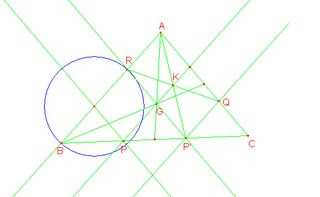
Digressions hints and clues about settlement
1) If verbalize the equal status of reasons it may be said that P, Q, R are based on the sides at the same rate, but also P 'part CB (BC reverse) in the same proportion as P part BC. This kind of symmetry is difficult to see at first glance (even to the trained eye). To the trained eye (in geometric problems Olympiad) likely this symmetry first acquires salience (something she suggests it is valuable scrutinize more closely) and only later is focused (looking implications derived
help the solution of the problem), and it if necessary to cover some details of the settlement plan.
However, after taking the picture, the cognized could be questioned whether the midpoint M of side BC is seen as the midpoint of PP 'only by the figure or is derivable from the condition. In my case, now that I address the problem years after that contest Monterrey, I explored this question at the end of the test as a need to come to a conclusion: that wanting to M was the midpoint of PP 'can prove to condition from the BP / PC = CP / P'B.
2) The application to demonstrate use Menelaus immediately suggests collinearity. But I suggest to anyone who knows the theorem and has experience with its instances of use. In 1997 I stayed just amazed that Valentina and I could do more partnerships that will link the data with geometric knowledge necessary for solving the problem (what to say to the solution ... I would have been happy if he had drawn the figure!) .
But suppose the cognized Menelaus can evoke from the statement. In that case, the following two tasks that immediately arise are a) finding the right triangle b) proceed to prove that the product of reason in the theorem of Menelaus is unity. (Note, incidentally, that the activation of the network of knowledge associated with Menelaus
- almost as if we had "zipped" in our mind - to cognizable provides an immediate action plan, your mind goes to work instead of keeping wandering in search of a useful idea - one that is wandering in the long sickening, especially when no useful idea comes.
3) Another clue to the solution that is included in the statement are the ratios RA / RB = CP '/ P'B (which almost immediately leads to the conclusion RP' parallel to AC) and QC / QA = CP ' / P'B (and seen to P'C is parallel to AB). These two ratios lead to the conclusion that the quadrilateral is parallelogram ARP'Q.
From here, cognizable eventually come to see that K is the intersection of diagonals which it could lead to another demonstration (No Menelaus) based on the idea that a medium must pass through the barycenter (centroid) - to which can be reached by a relatively random chain of associations, it also has to see that G is centroid of the triangle APP ' .
With random I mean that the action plan comes after the search for useful ideas (and there is a risk of failing to make them work even when they had sight) and not before as would be natural. With the evocation of the theorem of Menelaus, however, the plan is immediately and it will guide the action: it is like saying "What toolbox use for alignment problems?" - And the answer is and in the question itself ... if you had experience in instances of use of the theorem of Menelaus.
Solution (Menelaus)
Choosing the right triangle for the implementation of Menelaus is almost immediate: AMP is the triangle. " The next task is to show that (AG / GM) (MP / PP ') (P'K / KA) = 1. But this task is reduced to prove that MP / PP '= 1 / 2 for AG / GM = 2 / 1 for the attribute of the centroid location of the median and P'K / KA = 1 because the point K intersection of the diagonals of a parallelogram (the diagonals of a parallelogram bisect).
Here's where the need to demonstrate M is the midpoint of PP '(and not just BC). This can be proved by algebra. If k is the ratio BP / PC then from KPC and BP = CP '= kP'B can come to see that (k +1) PC = (k +1) P'B and therefore PC = P'B. Hence, PP '+ P'C = PP' + PB, ie P'C = PB. So BP + MP = MP '+ P'C and sees that PM = MP'.
Solution (without Menelaus)
Once knowing that M is the midpoint of PP 'show "atheoretical" (ie, elementary geometry) comes to mind from the image of the parallelogram ARPQ. Well, since G is also the centroid of the triangle APP '(the proportion MG / GA = 1 / 2 does not have to change), and since the diagonals of a parallelogram bisect each other, then the triangle median PK APP 'and must pass through G, ie, P, Q, K are collinear. Concluding Remarks
can be seen here (in the way the elementary solution arises or is suggested by the implementation of the solution requires more theory) that the solution "creative" is the least natural. This is because a plan to begin by saying "I will show that PK is average ..." is a plan unlikely. And also because the discovery that M is the midpoint of PP '(present in both shows) was a necessity in the plan Menelaus, and thus guided
by a goal, the ingredient that gives it natural.
Furthermore Menelaus cognizable maximizes efficiency by allowing complete the solution in less than an hour (I think). The moral I can draw from this problem is that the populism of many delegates and / or well-intentioned state coaches who argue that basic solutions Olympiad problems are always possible (as they are), hence to derive the conclusion (wrongly in my apparently) that adolescents who carry competitions require only natural creativity and basic skills, has the perverse effect of causing exactly what you want to avoid: the frustration of the boys.
In trying to avoid stress resulting from learning to demonstrate and use basic theorems and solve complex problems of competition only frustration Translates a week of competition, because there the children discover the futility of their tools in front of the complex tasks problems required a national contest for math Olympiad. [Although it could happen, as in my case the pageant of 97 coaches and delegates are innocent of populism, and simply be because, as Coxeter and Greitzer said, not familiar with the geometry (and other mathematical topics of competition).]


